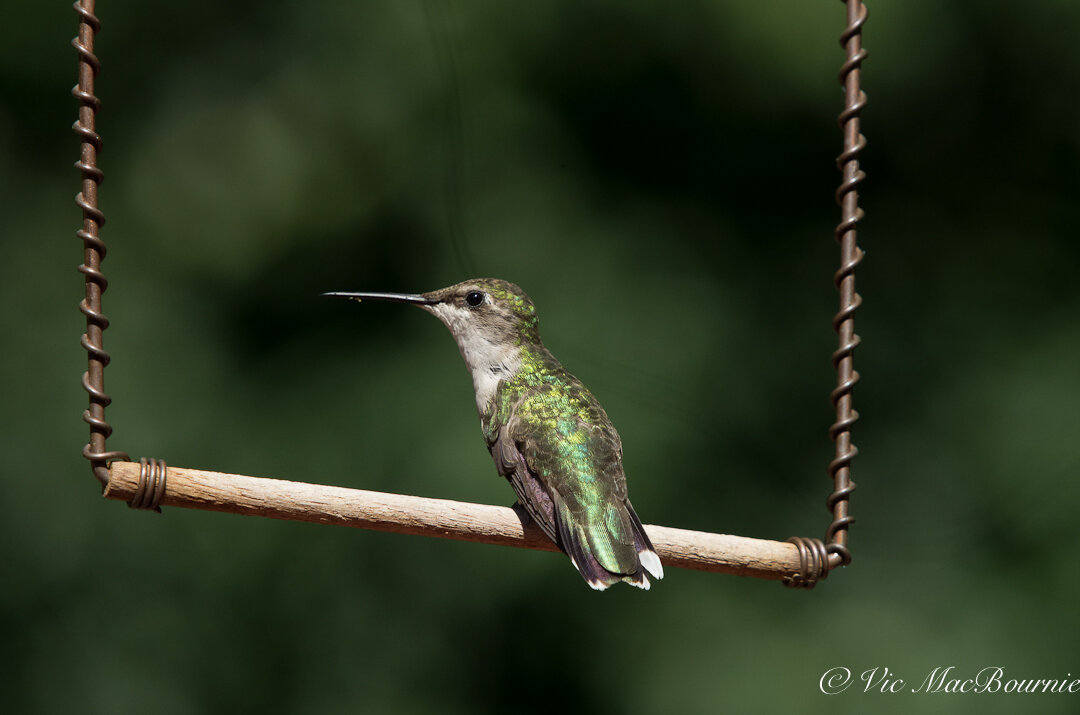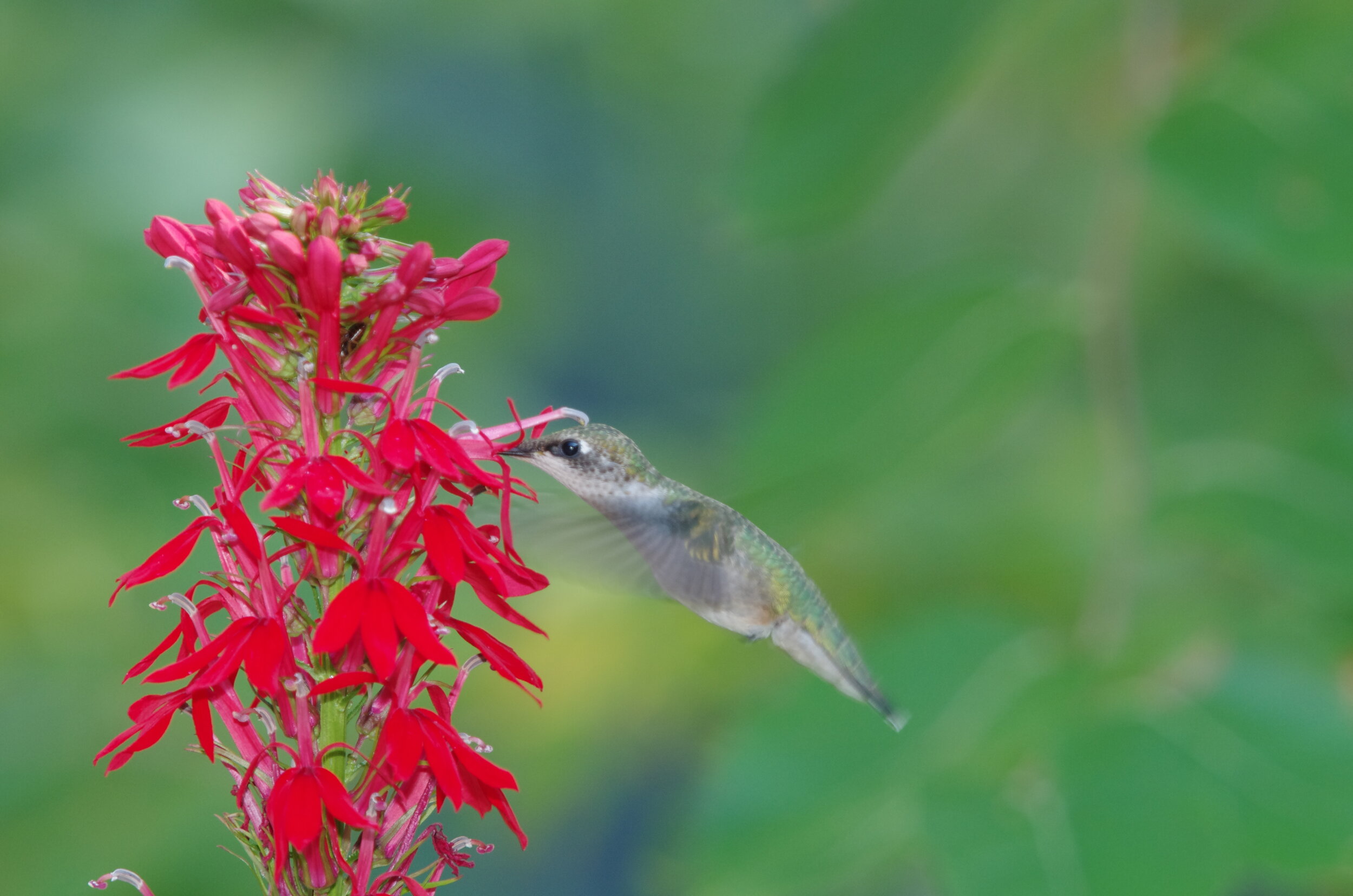How to help Hummingbirds during migration
How far do hummingbirds migrate
It’s hard to imagine our tiny hummingbirds embarking on a two-week journey all by themselves covering between 3,500 - 4,000 kms from southern Mexico to the Great Lakes area and returning to the same backyard feeder they left seven months earlier.
But for many of our little Ruby-throated hummingbirds, that is the miracle they perform twice a year. Some, who spend our winter in Central America, can travel even farther. If that wasn’t enough, every year thousands of hummingbirds make the dangerous journey over the open water of the Gulf of Mexico flying non-stop for up to 500 miles to reach the safe shores of the United States. That solitary flight alone can take up to 22 hours.
So when do hummingbirds do most of their flying?
Experts believe that hummingbirds begin their migration because of the changing level and angle of the sunlight. They then use the daylight hours during migration to do most of their flying. This way they can take advantage of the nectar sources along the route. Years of migration have taught them what flowers to watch for along the way and by flying low, the birds can actually see food sources and make regular pit stops to stock up on energy along the way.
How can we help Hummingbirds survive their journey?
Providing perches for Hummingbirds to rest near a food source is a great way to give them a needed rest as well as an opportunity to photograph them.
5 Tips to help Hummingbirds during migration
Ensure your commercial feeders are cleaned, and up a few weeks earlier than you would expect them to normally arrive. Keep them filled with a 4:1 mixture of 1 part regular white sugar and 4 parts of water. It’s best to boil the water first and dissolve all the sugar in the boiling water. place it in the refrigerator until cooled and then fill the feeders and hang them out in the garden. I have found that the feeder hanging off our home’s eavestrough attracts the most hummingbirds, but spread your feeders throughout the garden to give the hummers the best chance of seeing them as they pass through.
Put out fruit, say on a shallow birdbath, to attract fruit flies – a great source of protein for the migrating birds.
Refrain from using any insecticides in the garden to encourage as many small insects and spiders as possible. We should never be using insecticides but especially in the spring when the birds depend on insects for their survival and, if nesting, for their young.
Plant flowers to provide natural nectar for the migrating hummingbirds. If you do not have any early-flowering varieties, consider going to the nursery and picking up some flowering annuals that provide the birds with an early nectar source.
Provide a shallow birdbath or one with a gentle fountain for the birds. Hummingbirds need to keep their feathers in top shape and will flutter in and out of a gentle spray cleaning their feathers and/or taking a small drink. Hummingbirds do get most of their water needs met through the nectar they consume.
Native plants are best food source
Using native plants in the garden is the ideal way to give our hummingbirds the necessary food to survive the long migratory journey.
Experts say that the little birds have learned to take advantage of tail winds to help them travel more efficiently and burn less calories. Ruby-throated hummingbirds have been know to eat one to three times their weight every day.
For some, their journey is close to complete at that stage, but most keep going bringing them as far west as Texas and North Dakota and as far north as parts of central and eastern Canada. Many settle in and around the Great Lakes where gardeners in Toronto, Hamilton, Cleveland, Buffalo and Niagara Falls welcome them with open arms and a host of hummingbird feeders, cleaned and topped with fresh home-made nectar.
Still others, continue their journey farther north.
To better understand the extent of the journey the Cornell Lab of Ornithology estimates that the 3,900-mile migration from Alaska to Mexico is the equivalent of 78,470,000 body lengths to the 3-inch hummer. The Arctic Tern’s migration of about 11,185 miles is only 51,430,000 body lengths. That’s a mighty difference for such a tiny bird.
Getting to their final destination involves a perilous journey. Storms, cold snaps and injury all play a major role in whether they are able to finish this journey. So too does the availability of food along the way.
Another interesting fact is that along the migration, if a hummingbird gets caught in a cold spell, it will shut down and enter a sleep-like state called torpor. The hummingbird can be seen hanging upside down and looks to be dead, but in fact, it has dropped its body temperature and heart rate to conserve energy. It even goes so far as to make its breathing intermittent. Once temperatures rise, the hummingbirds will continue its journey.
Prior to setting off on their journey, whether it is the Fall migration south, or the spring migration north, a hummingbird will typically gain 25-40 per cent of their body weight this will help to sustain them in the first part of the journey but food sources along the way are critical for their survival.
Natural food sources are always the best for migrating birds and that includes an abundance of small insects that provide them with the necessary protein they will need to continue the journey. Gardeners in the southern states and along the migration route up to and including through parts of Canada need to ensure they are not only putting out commercial feeders and growing native, early blooming shrubs and flowers to help the hummingbirds along their way, they also need to put away any urge to reduce insects and spiders through the use of insecticides in their gardens and natural areas. These insecticides will limit the availability of insects at such a crucial time in the migration.
In fact, by putting out ripened fruit in spring, we can help give the hummingbirds a fresh supply of fruit flies during their migration. The fruit flies are an excellent source of protein and easy for the hummingbirds to eat in large quantities.
Gardeners are also urged to put commercial feeders, like this beautiful copper feeder from Gardener’s Supply, near natural nectar sources, most often red or orange tubular-shaped flowers. Consider columbine, honeysuckle and penstemon just to name a few. Lupines, foxgloves and hollyhocks are also favourite flowers for hummingbirds, although they bloom later in the season.
While I get great enjoyment from my bird feeding stations, providing natural food sources to our feathered friends is always the goal we should aspire to in our gardens. I have written a comprehensive post on feeding birds naturally. You can read about it here.
During that migration, where these tiny birds can travel up to 23 miles and day, they consume more than their weight in nectar and insects every single day. Hummingbirds have an average of 53 wing beats per second (ranging from as low as 15 to as high as 80) and a heart rate of 1,260 beats per minute, so you can imagine how much food they need just to keep up with the incredible amount of energy they expend on the journey.
To say their journey is complicated is an understatement. If they travel too fast they will run the risk of outrunning the early blooming times of the native flowers along the route. Too slow, and they might not get to their destination in time to recover and begin the process of reproduction.
The other factor that is growing in importance and potentially threatening hummingbirds is climate change. Most gardeners are aware of the changing agricultural zones that climate change has brought on many of our own gardens. That same change is having some impact on the availability of flowering plants that the hummers depend on during their journey. Already, experts are saying that 10 per cent of all hummingbird species worldwide are threatened with extinction. The introduction of more commercial hummingbird feeders are likely to become an increasingly important source of nectar for the birds as they migrate through the United States and up into Canada.
At the time of writing this post On Thursday March 11, the hummingbirds were gathering in the southern states with reports of Ruby-throated hummingbirds in Riverside, Alabama, Jackson Mississippi, Georgia and North Carolina. Many of these may have simply chosen to spend the winter in these warmer climates, but there is no doubt the migration is beginning to pick up steam.
If you want to follow the spring migration as it works its way through the United States from Central America and Mexico into Canada, sign up for my free newsletter which will be tracking the migration and reporting back to subscribers throughout the spring. Sign up for the free newsletter at the bottom of my home page here.
As an affiliate marketer with Amazon or other marketing companies, I earn money from qualifying purchases.



